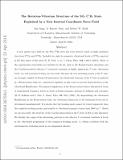The rotation-vibration structure of the SO[subscript 2] C̃[superscript 1]B[subscript 2] state explained by a new internal coordinate force field
Author(s)
Jiang, Jun; Park III, George Barratt; Field, Robert W
DownloadField_The rotation-vibration.pdf (1.124Mb)
OPEN_ACCESS_POLICY
Open Access Policy
Creative Commons Attribution-Noncommercial-Share Alike
Alternative title
The Rotation-Vibration Structure of the SO2 C˜ 1B2 State Explained by a New Internal Coordinate Force Field
Terms of use
Metadata
Show full item recordAbstract
A new quartic force field for the SO[subscript 2] C̃ [superscript 1]B[subscript 2] state has been derived, based on high resolution data from S[superscript 16]O[subscript 2] and S[superscript 18]O[subscript 2]. Included are eight b[subscript 2] symmetry vibrational levels of S[superscript 16]O[subscript 2] reported in the first paper of this series [G. B. Park et al., J. Chem. Phys. 144, 144311 (2016)]. Many of the experimental observables not included in the fit, such as the Franck-Condon intensities and the Coriolis-perturbed effective C rotational constants of highly anharmonic C̃ state vibrational levels, are well reproduced using our force field. Because the two stretching modes of the C̃ state are strongly coupled via Fermi-133 interaction, the vibrational structure of the C̃ state is analyzed in a Fermi-system basis set, constructed explicitly in this work via partial diagonalization of the vibrational Hamiltonian. The physical significance of the Fermi-system basis is discussed in terms of semiclassical dynamics, based on study of Fermi-resonance systems by Kellman and Xiao [J. Chem. Phys. 93, 5821 (1990)]. By diagonalizing the vibrational Hamiltonian in the Fermi-system basis, the vibrational characters of all vibrational levels can be determined unambiguously. It is shown that the bending mode cannot be treated separately from the coupled stretching modes, particularly at vibrational energies of more than 2000 cm[superscript −1]. Based on our force field, the structure of the Coriolis interactions in the C̃ state of SO[subscript 2] is also discussed. We identify the origin of the alternating patterns in the effective C rotational constants of levels in the vibrational progressions of the symmetry-breaking mode, νβ (which correlates with the antisymmetric stretching mode in our assignment scheme).
Date issued
2016-04Department
Massachusetts Institute of Technology. Department of ChemistryJournal
The Journal of Chemical Physics
Publisher
American Institute of Physics (AIP)
Citation
Jiang, Jun, G. Barratt Park, and Robert W. Field. “The Rotation-Vibration Structure of the SO[subscript 2] C̃[superscript 1]B[subscript 2] State Explained by a New Internal Coordinate Force Field.” The Journal of Chemical Physics 144.14 (2016): 144312.
Version: Author's final manuscript
ISSN
0021-9606
1089-7690